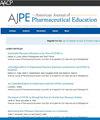卫生专业教学中药物计算教学与评估策略的范围回顾。
IF 3.5
4区 教育学
Q1 EDUCATION, SCIENTIFIC DISCIPLINES
引用次数: 0
摘要
简介:精通药物计算是医疗保健专业人员必不可少的基本技能,因为药物剂量和配药错误可能导致严重的患者伤害。尽管这很重要,但研究表明,许多卫生专业教育(HPE)的学生在掌握这些概念方面面临挑战。这个范围审查的目的是探讨现有文献的药物计算教学和评估策略在HPE。方法:在PubMed、Scopus、ERIC和CINAHL Complete中进行综合检索。如果研究论文的全文涉及HPE学生,在教学课程中讨论药物计算,并提供英文版本,则纳入。结果报告使用首选报告项目为系统评价和荟萃分析扩展范围评价(PRISMA-ScR)。结果:73篇文章符合纳入标准,大部分为准实验研究。57.5%的研究涉及护士学生,35.6%的研究涉及药剂师学生。教学策略多种多样,解决问题的方法、模拟和在线学习是最常见的。考试是最常见的评估策略。33%的研究评估了能力,阈值从70-100%不等。结论:虽然药学计算教育仍然是HPE课程的重要组成部分,但本综述发现缺乏有力的证据支持教学或评估干预来改善学习成果。需要进一步的研究来确定各种药物计算教学和评估策略的比较有效性。本文章由计算机程序翻译,如有差异,请以英文原文为准。
A Scoping Review of Teaching and Assessment Strategies for Pharmaceutical Calculations in Health Professions Education
Objective
Proficiency in pharmaceutical calculations is an essential and fundamental skill for health care professionals, as medication dosing and dispensing errors can result in serious patient harm. Despite this importance, research suggests that many health professions education (HPE) students face challenges in mastering these concepts. This scoping review aims to explore the available literature on pharmaceutical calculations, teaching and assessment strategies within HPE.
Methods
A comprehensive search was conducted in PubMed, Scopus, ERIC, and CINAHL Complete. Full-text research articles were included if they involved HPE students, discussed pharmaceutical calculations in the didactic curriculum, and were available in English. Results were reported using the Preferred Reporting Items for Systematic Reviews and Meta-Analyses extension for Scoping Reviews.
Results
Seventy-three articles met the inclusion criteria, with the majority being quasi-experimental studies. Of the studies, 57.5% involved student nurses and 35.6% involved student pharmacists. Teaching strategies varied, with problem-solving approaches, simulation, and online learning being the most common. Examinations were the most frequently used assessment strategy. Competency was assessed in 33% of the studies, with thresholds ranging from 70% to 100%.
Conclusion
While pharmaceutical calculations education remains a crucial component of HPE curricula, this review found a lack of robust evidence supporting specific teaching or assessment interventions to improve learning outcomes. Additional research is needed to determine the comparative effectiveness of various teaching and assessment strategies for pharmaceutical calculations.
求助全文
通过发布文献求助,成功后即可免费获取论文全文。
去求助
来源期刊
CiteScore
4.30
自引率
15.20%
发文量
114
期刊介绍:
The Journal accepts unsolicited manuscripts that have not been published and are not under consideration for publication elsewhere. The Journal only considers material related to pharmaceutical education for publication. Authors must prepare manuscripts to conform to the Journal style (Author Instructions). All manuscripts are subject to peer review and approval by the editor prior to acceptance for publication. Reviewers are assigned by the editor with the advice of the editorial board as needed. Manuscripts are submitted and processed online (Submit a Manuscript) using Editorial Manager, an online manuscript tracking system that facilitates communication between the editorial office, editor, associate editors, reviewers, and authors.
After a manuscript is accepted, it is scheduled for publication in an upcoming issue of the Journal. All manuscripts are formatted and copyedited, and returned to the author for review and approval of the changes. Approximately 2 weeks prior to publication, the author receives an electronic proof of the article for final review and approval. Authors are not assessed page charges for publication.

 求助内容:
求助内容: 应助结果提醒方式:
应助结果提醒方式:


